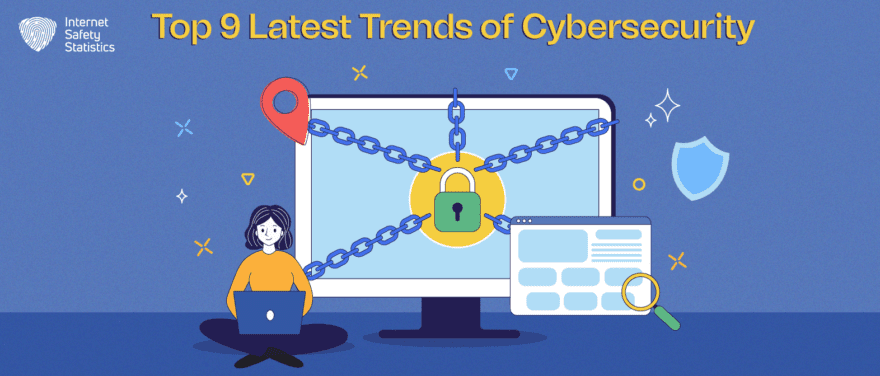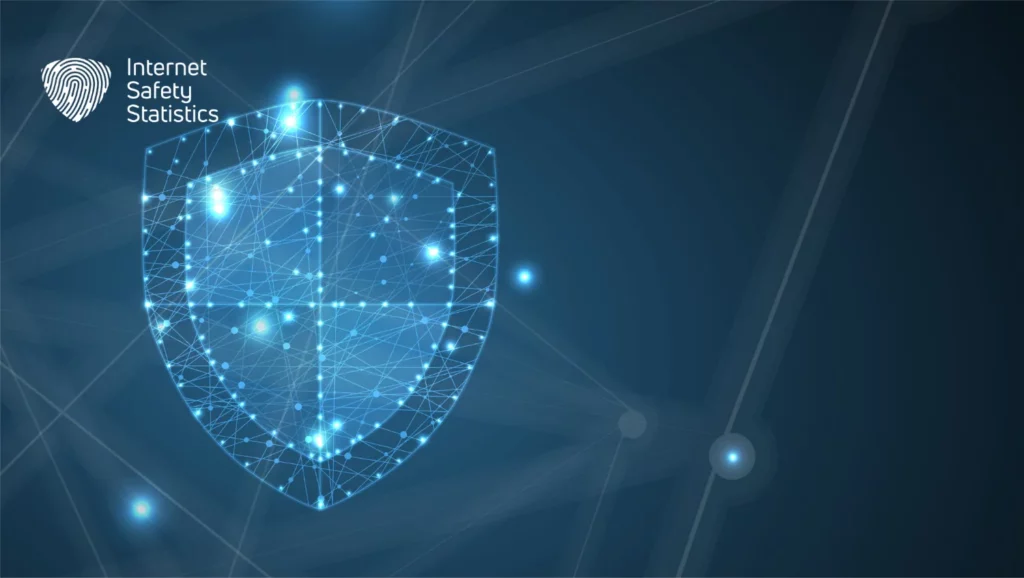
In our ever-expanding digital age, the latest trends of cybersecurity stand as the steadfast vanguard of online safety. As internet intricacies and complexities grow exponentially, so does the pressing urgency to shield against multifaceted threats.
This landscape has spurred rapid advancements, innovative strategies, and novel solutions. The continuously unfolding latest trends of cybersecurity, now more vital than ever to our interconnected era, serve as a powerful testament to the industry’s unwavering commitment to fortifying our vast and intricate virtual domains.
What Are The Latest Trends of Cybersecurity?
Step into the ever-evolving realm of cybersecurity, where the lines between humans and technology are progressively merging. From the emphasis on user-centric designs to the overarching strategic shifts in operational models, the trends of cybersecurity are painting a picture of innovation and adaptation.
As we zero in on the human experience with Human-Centric Security Design and turn inwards with “quiet hiring”, one message stands out: people are pivotal. Organisations are not just fortifying defences but are reimagining, validating, and evolving them to keep pace with rapid technological changes.
As boardrooms globally take a proactive stance in cybersecurity decision-making, strategies are resonating from the top down. Dive with us into this riveting exploration of the latest trends of cybersecurity as we map a future where security seamlessly integrates into every business facet, promising a safer and more resilient digital world.
1. Human-Centric Security Design
Navigating through the intricate web of current cybersecurity trends, it’s evident that the Human-Centric Security Design is more than just a fleeting phase; it’s a profound evolution in how we approach digital protection.
This trend responds to a broader recognition in the tech industry, understanding that as technology becomes more integrated into daily life, the barrier between the user and the tool should be as frictionless as possible. The challenges of the past, where rigorous security protocols often clashed with user experience, are being re-evaluated.
As cyber threats diversify, the focus isn’t solely on creating impenetrable walls but on ensuring that these walls can be easily navigated by authorised users. Training, awareness campaigns, and user feedback loops are becoming standard practices, ensuring that as cybersecurity trends evolve, they remain rooted in the needs and preferences of the very people they aim to protect.
2. People Management for Sustainability

Amid the myriad of cybersecurity latest trends, the pivotal role of human capital stands out more than ever. While technology hurtles forward at an unprecedented pace, the more human aspect of cybersecurity is taking centre stage.
It’s becoming clear that while automated tools and algorithms are vital, the insights, intuition, and adaptability that humans bring are irreplaceable. This human-centric shift in cybersecurity trends aligns with the broader global trend of emphasising employee well-being, continuous learning, and adaptability.
By focusing on “quiet hiring” and prioritising internal talent, organisations not only address the technical aspects of cybersecurity but also promote a culture of vigilance and accountability. After all, while technology can detect and defend, it is people who innovate and adapt. As we navigate the future, the synergy between human expertise and technological prowess will be the cornerstone of robust cybersecurity strategies.
3. Transformation of Cybersecurity Operating Models

Modern businesses, amidst a backdrop of an increasingly interconnected and volatile digital landscape, are recognising the imperative to evolve their cybersecurity frameworks. No longer just an IT concern, cybersecurity has found its place at the strategic centre of business operations.
The current trend gravitates towards the comprehensive overhauling of security functions, emphasising not just protection but also value creation and innovation enablement. By intertwining cybersecurity endeavours with core business strategies, organisations aim to build a robust yet agile protective layer. The goal is more than just countering technological threats; it’s about fostering a culture where employees, from the boardroom to the frontline, are empowered with the knowledge and tools to navigate the multifaceted landscape of risks.
This includes understanding potential financial pitfalls, managing brand and reputational integrity, and staying compliant in an ever-changing legal environment. The endgame of this transformation is clear: to craft a future where business aspirations and security imperatives not only coexist but thrive together, propelling organisations towards sustainable success in a digitised world.
4. Threat Exposure Management
In the dynamic realm of the latest cybersecurity trends, continuous threat exposure management has taken a pivotal position. As our digital evolution marches forward relentlessly, organisations are pivoting to proactive strategies to comprehend and mitigate their vulnerability to emerging threats.
With this trend, there’s a pressing need to harmonise assessment practices with the fluid shifts in work paradigms and the ever-changing technological vulnerability landscape. Beyond just reactive measures, the spotlight in today’s cybersecurity trends is on sustained vigilance.
The objective is clear: to ensure businesses remain a step ahead, proactively identifying and countering potential cyber threats. This approach embraces both technological fortifications and the intricacies of human factors, supply chain dependencies, and third-party associations, ensuring a comprehensive protective stance in the digital age.
5. Identity Fabric Community
One of the standout cybersecurity trends is the emphasis on ‘Identity Fabric Immunity’. In our interconnected digital era, where data breaches and identity theft are rampant, the integrity of identity infrastructures becomes more than just a technical concern—it’s a foundational element of trust in digital interactions.
This trend dives deep into the vulnerabilities often overlooked in traditional models, championing the establishment of robust identity frameworks. The focus isn’t just on reactive measures but on proactively creating systems that are resilient to emerging threats. By fortifying the identity fabric and ensuring its optimal configuration, organisations not only aim to prevent unauthorised access but also ensure smoother user experiences.
Furthermore, with regulatory environments growing stricter, having a fortified identity infrastructure can also help organisations in compliance adherence. As the digital landscape evolves and cyber threats grow in complexity, the emphasis on identity signifies its pivotal role in not just security but in ensuring business continuity and trust in digital ecosystems.
6. Cybersecurity Validation
A forefront development in contemporary cybersecurity trends is the rise of ‘Cybersecurity Validation’. This proactive approach employs a suite of techniques, processes, and tools designed to emulate potential attackers, assessing their exploitation methods against identified threat exposures.
Through this real-world simulation, organisations can pinpoint weak spots in their defences, allowing for targeted improvements. Such validation provides regular benchmarks, illuminating the effectiveness of current security controls and processes. Additionally, providing insights into potential gaps helps shape training and awareness programs for employees.
By mimicking genuine threats, organisations can more accurately gauge their defence readiness, refine their response strategies, and anticipate future vulnerabilities. This holistic approach ensures that security measures evolve in tandem with the ever-shifting threat landscape, providing a robust shield against cyber adversaries.
7. Cybersecurity Platform Consolidation
In the realm of the latest trends of cybersecurity, ‘Cybersecurity Platform Consolidation’ has taken centre stage as a strategic focal point for organisations. By unifying platforms across key cybersecurity domains, the aim is not only to streamline operations but to create a harmonised ecosystem where tools and processes interoperate seamlessly.
This holistic approach reduces the complexities of managing multiple standalone systems, thereby minimising potential gaps or overlaps. The push towards a unified platform for identity security services exemplifies this direction. By amalgamating governance, privileged access, and access management features into a singular platform, organisations can offer a more comprehensive identity protection framework.
Moreover, this consolidation fosters better data analytics and threat intelligence as information flows are centralised. The end goal is a more agile and adaptive security infrastructure capable of responding swiftly to emerging threats while ensuring resource optimisation and enhancing the organisation’s overall cybersecurity stance.
8. Composable Security for Composable Businesses

One standout in the dynamic landscape of the latest trends of cybersecurity is Composable Security for Composable Businesses. As modern enterprises transition from monolithic systems to more adaptable, modular architectures, there’s a parallel shift in cybersecurity approaches.
This trend underscores the importance of embedding cybersecurity controls within the modular facets of composable technology implementations.
Such integration ensures nimble and bespoke security configurations for each application component. With the rapid pace of business change, this trend offers a flexible, real-time response, epitomising the evolving nature of cybersecurity measures in our dynamic digital era.
9. Enhanced Board Competency in Cybersecurity Oversight
As the digital realm permeates every facet of business operations, a transformative shift is witnessed among the organisational hierarchy’s top echelons. One of the more pronounced cybersecurity trends is the Enhanced Board Competency in Cybersecurity Oversight. No longer relegated to just IT departments, cybersecurity has ascended the boardroom agenda.
Driven by the push towards executive-level accountability, boards are now actively engaging in cybersecurity decision-making processes. This trend underscores the necessity to regularly report and elucidate the significance of cybersecurity programs in the context of broader organisational goals and objectives. It’s a clear testament to cybersecurity’s elevated importance and strategic alignment in shaping the modern enterprise’s trajectory.
As the digital realm continues its relentless expansion, staying abreast of the latest trends of cybersecurity becomes essential. These trends not only reflect our current challenges but also light the path to a safer digital future. By understanding and adapting to these shifts, businesses and individuals alike can navigate the digital seas with enhanced confidence and security.
